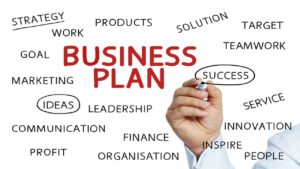Writing a business plan is an important activity to attract investment and grow your company.
Writing an Executive Summary for Your Business Plan
 This is an overview of your business and your plans.
This is an overview of your business and your plans.
The executive summary of your business plan introduces your company, explains what you do, and lays out what you’re looking for from potential investors and strategic business partners.
Because the executive summary is a critical component of your business plan, ensure that it is as clear and concise as possible. Cover the key highlights of your business, in a way that sparks interest, and make investors eager to know more.
Include a one-sentence overview of your business that sums up the essence of what you are doing. This is known as a value proposition.
In one or two sentences, summarise the problem you are solving in the business market.
How is your product or service addressing the problem you have identified in the market?
Who is your target market? How many of them are there? It’s important to be specific. You are most likely targeting a specific market segment. This will make it easy for you to target your marketing and sales efforts and attract the kinds of consumers that are most likely to buy from you.
How is your target market solving their problem today? Are there alternatives or substitutes in the market? It is critical to provide an overview of your competition.
Provide a brief overview of your team and a short explanation of why you and your team are the right people to take your idea to market. Investors put an enormous amount of weight on the team because a great idea needs great execution in order to become a reality.
Highlight the key aspects of your financial plan, showing planned sales, expenses, and profitability. Include a short statement indicating how much money you need to raise.
The last key element of an executive summary that investors will want to see is the progress that you’ve made so far and future milestones that you intend to hit.
Writing an Opportunity for Your Business Plan
What are you actually selling and how are you solving a need for your market? Who is your target market and competition?
 Include information about the problem that you’re solving, your solution, who you plan to sell to, and how your product or service fits into the existing competitive landscape. Demonstrate what sets your solution apart from others, and how you plan to expand your offerings in the future.
Include information about the problem that you’re solving, your solution, who you plan to sell to, and how your product or service fits into the existing competitive landscape. Demonstrate what sets your solution apart from others, and how you plan to expand your offerings in the future.
Describe the problem that you are solving for your customers. What is the primary pain point for them? How are they solving their problems today? Maybe the existing solutions to your consumer’s problem are very expensive or cumbersome. For a business with a physical location, perhaps there aren’t any existing solutions within reasonable driving distance.
Defining the problem you are solving for your consumers is the most critical element of your business plan and crucial for your business success. If you can’t pinpoint a problem that your potential business customers have, then you might not have a viable business concept.
Target Market
To ensure that you are solving a real problem for your potential consumers, talk to potential customers. Validate that they have the problem you assume they have, and then take the next step and pitch your potential solution to their problem. Is it a good fit for them?
Once you have described your target market’s problem, describe your solution. Your solution is the product or service that you plan on offering to your consumers. What is it and how is it offered? How exactly does it solve the problem that your consumers have?
You need to know who your target market is and have a rough estimate of how many of them there are. If there aren’t enough consumers for your product or service, that could be a warning sign.
A market analysis starts with research. First, identify your market segments and determine how big each segment is. A market segment is a group of people or other businesses that you could potentially sell to. Provide some data to indicate how fast each segment is growing. Discuss the trend for these markets. Are they growing or shrinking? Talk about the market’s evolving needs, tastes, or upcoming changes to the market.
When you have your target market segments defined, it’s time to define your ideal consumer for each segment. This will be an extremely useful tool to help you identify the marketing and sales tactics you’ll need to use to attract these ideal consumers.
Competition
 Immediately following your target market section, you should describe your competition. Who else is providing solutions to try and solve your consumers’ pain points. What are your competitive advantages over them?
Immediately following your target market section, you should describe your competition. Who else is providing solutions to try and solve your consumers’ pain points. What are your competitive advantages over them?
The most important thing to illustrate in this section is to illustrate how your solution is different or better than other offerings that a potential consumer might consider. Investors will want to know what advantages you have over the competition and how you plan on differentiating yourself.
One of the biggest mistakes entrepreneurs make is stating that they don’t have any competition.
All businesses have competition. Competitors may not always come in the form of “direct competition”, which is when a competitor offers a similar solution to your offering. Often, you may be dealing with “indirect competition”, which is when consumers solve their problem with an entirely different kind of solution.
All entrepreneurs have a vision of where they want to take the business in the future if they are successful.
Include a paragraph or two about potential future plans, to show where you are headed in the long term. The focus should be on bringing your first products and services to market.
Writing an Execution for Your Business Plan
How are you going to take your opportunity and turn it into a business? This section will cover your marketing and sales plan, operations and your milestones for success.
Marketing and Sales Plan
This details how you plan to reach your target market segments, how you plan on selling to those target markets, what your pricing plan is, and what types of activities and partnerships you need to make your business a success.
 Positioning is how you will present your company to your consumers. Are you the low-price solution; or are you the premium, luxury brand in your market. Do you offer something that your competitors don’t?
Positioning is how you will present your company to your consumers. Are you the low-price solution; or are you the premium, luxury brand in your market. Do you offer something that your competitors don’t?
Take a little time to evaluate the current market and answer the following questions:
- What features or benefits do you offer that your competitors don’t?
- What are your consumer’s primary needs and wants?
- How are your competitors positioning themselves?
- Why should a consumer choose you instead of a competitor?
- Where do you see yourself in the landscape of other solutions?
Your positioning strategy will often be a major driver of how you price your offerings. Price sends a very strong message to consumers. If you are offering a premium product, a premium price will quickly communicate that message to consumers.
A promotion plan details how you plan on communicating with your prospects and customers.
If you are selling a product, packaging is critical. Including images of your packaging in the business plan is a good idea.
Your business plan should include an overview of the kinds of advertising you plan to spend money on. Having a social media presence is a requirement for the vast majority of businesses. Prospects are using social media to learn about companies and to find out how responsive they are.
Operations
The logistics, technology, and other nuts and bolts.
If your company is buying the products it sells from other vendors, include details of where your products come from, how they get delivered to you, and how you deliver the products to the consumer. This is sourcing and fulfillment. If you source products from manufacturers overseas, investors are going to want to know about your progress working with these suppliers. If your business is going to be delivering products to your consumers, describe your plans for shipping your products.
 If you are a technology company, it is critical for your business plan to describe your technology. You don’t have to give away trade secrets in your business plan but you do need to describe how your technology is different and better than other solutions out there. You don’t need to go into excruciating detail- if an investor is interested in more detail, they will ask for it, and you can provide that information in your appendix.
If you are a technology company, it is critical for your business plan to describe your technology. You don’t have to give away trade secrets in your business plan but you do need to describe how your technology is different and better than other solutions out there. You don’t need to go into excruciating detail- if an investor is interested in more detail, they will ask for it, and you can provide that information in your appendix.
For product companies, a distribution plan details how you will get your product into the hands of your consumers. Every industry has different distribution channels and the best way to create your distribution plan is to interview others in your industry to figure out what their distribution model is.
Selling directly to consumers is by far the most simple and most profitable option. You will still need to cover the logistics of how you will get your products to your consumers from your warehouse, but a direct distribution model is usually fairly simple.
Most large retailers prefer to buy through large distribution companies that aggregate products from many suppliers and then make that inventory available to retailers to purchase. These distributors take a percentage of the sales that pass through their warehouses.
Manufacturers’ representatives often have relationships with retailers and distributors, and work to sell your products into the appropriate channel. They typically work on commission and it’s not uncommon for a rep to get a new company access to a distributor or retailer.
Most companies use a mixture of distribution channels as part of their plans.
Milestones for Success
Investors will want to see that you understand what needs to happen to make your plans a reality and that you are working on a realistic schedule. Milestones are planned major goals. If you are producing a consumer product, you may have milestones associated with prototypes, finding manufacturers, and first-order receipt.
Your business plan should detail the key assumptions you have made that are important for your business’s success. Another way to think about key assumptions is to think about risk.
Knowing what your assumptions are as you start a business can make the difference between business success and business failure. When you recognise your assumptions, you can set out to prove that your assumptions are correct. The more that you can minimise your assumptions, the more likely it is that your business will succeed.
Writing a Company and Management Summary for Your Business Plan
 Investors look for great teams in addition to great ideas. Describe your current team and who you need to hire. Provide a quick overview of your company, location and history, if you’re already up and running. It should show that you have thought about the important roles and responsibilities your business needs in order to grow and be successful. Include brief bios that highlight relevant experiences of each key team member.
Investors look for great teams in addition to great ideas. Describe your current team and who you need to hire. Provide a quick overview of your company, location and history, if you’re already up and running. It should show that you have thought about the important roles and responsibilities your business needs in order to grow and be successful. Include brief bios that highlight relevant experiences of each key team member.
Your management team doesn’t necessarily need to be complete in order to have a business plan. If you know that you have management team gaps, investors see this as a sign of maturity and knowledge about what your business needs to succeed. Simply identify them and indicate that you are looking for the right people to fill certain roles.
Include a proposed organisational chart. It is a useful planning tool to help you think about your company and how it will grow over time.
The company overview will include:
- Mission statement;
- Intellectual property;
- A review of your company’s legal structure and ownership;
- The business location; and
- A brief introduction of the company
A mission statement should be simple and encompass everything from the products made to the kind of marketing done.
Intellectual property mostly applies to technology and scientific ventures. It helps your business defend itself against competitors. If you have patents or are in the patent application process, highlight them. If you are licencing core technology from someone else, disclose that in your business plan, and be sure to include details of the financial relationship.
Your company overview should include a summary of your company’s current business structure? Are you a (Pty) Ltd? A close corporation? A co-operative?
Be sure to provide a review of how the business is owned. Does each business partner own an equal portion of the business? How is ownership divided?
Writing a Financial Plan for Your Business Plan
This includes financial forecasts and a summary of funds required. We will tell you what to include in your financial plan.
 A typical financial plan will have monthly sales and revenue projections for the first 12 months, and annual projections for the first five years.
A typical financial plan will have monthly sales and revenue projections for the first 12 months, and annual projections for the first five years.
A sales forecast is a projection of how much you are going to sell over the next few years.
Direct costs show the expenses related to making your product or delivering your service.
A personnel plan details how much you plan on paying your employees.
A profit and loss statement pulls data from your sales forecast and personnel plan, and also includes a list of all other ongoing expenses associated with running the business. Your expenses are subtracted from your earnings to show if your business is making a profit each month or potentially incurring some losses while you grow. A typical spreadsheet will include the following:
- Sales;
- Cost of sales;
- Gross profit;
- Operating expenses;
- Total operating expenses;
- Operating income;
- Interest and taxes;
- Total expenses; and
- Net profit.
 A cash flow statement keeps track of how much cash you have at any given point; adding new cash received through cash sales and paid invoices, and then subtracts cash that you have paid out.
A cash flow statement keeps track of how much cash you have at any given point; adding new cash received through cash sales and paid invoices, and then subtracts cash that you have paid out.
A balance sheet provides an overview of the financial health of your business. It lists the assets in your company, the liabilities, and the owner’s equity. If you subtract the company’s liabilities from assets, you can determine the net worth of the company.
Include a brief section that details exactly how you plan on using your investor’s cash. These include marketing, research and development, buying or leasing property, or purchasing inventory.
An exit strategy is a plan for eventually selling your business. Investors will want to know your thoughts on this. Your investors will want to get a return on their investment, and the only way they will get this is if the company is sold to someone else. Identify some companies that might be interested in buying you if you are successful.
Writing an Appendix for Your Business Plan
 More space may be required for product images and additional information; such as charts, tables, definitions, legal notes, or other critical information that either felt too long or too out-of-place to include elsewhere in your business plan. If you have a patent or patent pending, or illustrations of your product, this is where you’d want to include the details.
More space may be required for product images and additional information; such as charts, tables, definitions, legal notes, or other critical information that either felt too long or too out-of-place to include elsewhere in your business plan. If you have a patent or patent pending, or illustrations of your product, this is where you’d want to include the details.
Contact us for more information on writing your business plan.

